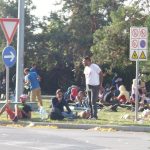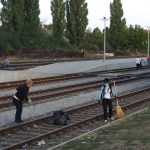Of almost 300,000 migrants passing through Croatia, only 10 have claimed asylum, with not a Syrian among them. Where are they from?
Since the beginning of the migration crisis in Croatia on 16 September, 287,225 migrants have entered Croatia, who have been brought to temporary refugee centres, and then transported further towards their desired destinations in the Western Europe. However, for a few of them, Croatia is their promised land. So far, ten people have applied for international protection in the Republic of Croatia. There are five Iraqi nationals, two Cubans, and citizens of Gambia, Sierra Leone and Russia, who came to Croatia with the migration wave from Serbia. While their requests are being considered, they are accommodated in Kutina, Ježevo or in private accommodation, according to the already established practice, reports Vecernji List on October 31, 2015.
For the 10 asylum seekers, the procedure is the same as for almost 4,000 other people who have asked for asylum in Croatia in the last five years. By far the most of them were Afghans, followed by citizens of Somalia, Algeria and Syria. The largest inflow was in 2012 and 2013, with a total of 2,284 persons, but then a huge decline happened. “This situation is likely the consequence of the fact that Croatia is not part of the Schengen Area, unlike Hungary, so it was not on the path of migratory smuggling routes”, according to Croatian Interior Ministry.
About 75 percent of applicants for international protection in recent years have left Croatia before the end of the asylum proceedings. However, some had managed to prove that the return to their homeland would bring persecution for reasons of race, religion, nationality, political opinion or membership of a particular social group, which is a condition for receiving asylum protection.
So far, the international protection has been granted to 165 people: 94 persons have been granted asylum, while 71 persons enjoy subsidiary protection. For each accommodated person, Croatia can ask for 6,000 euros of aid from European funds, as well as 10,000 euros in case of members of vulnerable groups.
“The Republic of Croatia is a signatory to numerous conventions which protect human rights, as well as the European directives that have been implemented in the Croatian legislation. To provide shelter is not only a legal duty of Croatia, but also a moral obligation”, representatives of the Ministry of Interior explain.
In the meantime, the flow of refugees to Croatia continues. From midnight to 9 pm on Friday, 6,627 migrants entered Croatia. At the temporary reception centre in Opatovac there are currently 3,003 migrants.
Croatian policemen in Melinovac, in the municipality of Donji Lapac, on Wednesday captured a Syrian national who tried to illegally cross the border between Bosnia and Herzegovina and Croatia. The Syrian was arrested and transferred to a reception centre for foreigners, the Lika-Senj Police Department reported.
According to the Slovenian police, that country has received 108,000 migrants and refugees, but in the last few days their inflow has been decreased to about 8,000 a day. After the agreement with Austria and Croatia, there are just two entry and exit points for migrants, Dobova at the Croatian border and Šentilj at the Austrian border.
Germany and Austria have decided to restrict the passage of migrants to just five points of their common border in order to help control their mass influx, the German Ministry of the Interior announced. “We want to create a regulated process,” the ministry spokeswoman said.
Berlin and Vienna agreed in September to leave their borders open to refugees, and that decision has accelerated the influx of people fleeing from war or poverty. The controls at the borders were re-introduced in mid-September, but migrants could enter Germany at any point. The vast majority of asylum seekers are crossing over 800 kilometres long border between Austria and Bavaria.
Austria has been for weeks organizing the transport of thousands of migrants to Germany, but many come individually and frequently cross the border through the woods. German interior minister Thomas de Maiziere sharply reproached Austria due to its behaviour. Germany predicts that this year it will receive between 800,000 and one million asylum seekers.
French president Francois Hollande called on Friday for countries not to raise walls and fences within Europe. He met in Paris with Austrian chancellor Werner Faymann, whose country is faced with an influx of refugees on its border with Slovenia and is considering such measures. “We should not raise walls and fences within Europe, but we should protect our external border”, said the French president during a joint press conference with Faymann.
Faymann said that only a common European answer can bring resolution. “Redirecting refugees towards neighbouring countries cannot be the answer in Europe”, Fayman said. “It is a difficult challenge, because political officials must show that we are sensitive to the fears of the population,” the Austrian chancellor added. However, “Europe is stronger than jealousy, envy, hatred, anger and prejudice”, he concluded.










